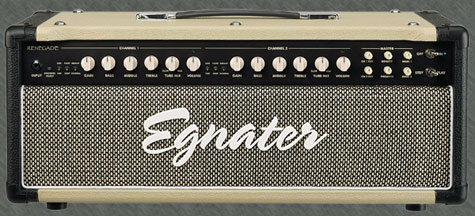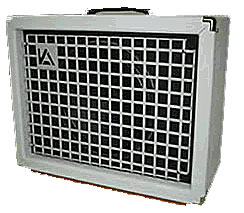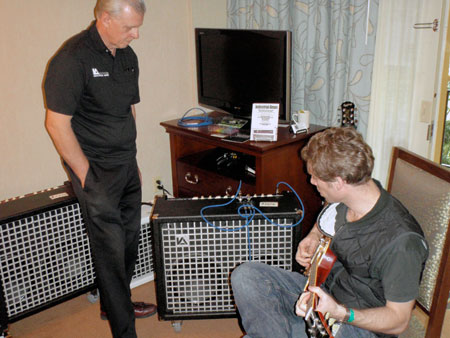NY/NJ Amp Show: More Great Stuff
Part 2: Egnater, Sommatone, Industrial Amps

In case you haven’t read part 1 yet, read that first. Just as a reminder, unless otherwise noted I’m playing through these amps with a P-90-equipped Epiphone Gold Top.
Blending Tubes at Egnater
From Lollar, where part 1 of this “show review” ended, I went next door to Egnater Custom Amplification. I wanted to check out their stuff because it’s written up often, because a lot of people have been talking up the Rebel 20 head and because Bruce Egnater has achieved a reputation over the years as an amp guru.
Plus Egnater has developed a way to blend two types of power tubes in the same amp or head. Sounded cool, so I wanted to hear it.
When I walked in, other guys were playing and the amps sounded good – which in my experience at the show was par for the course: All the amps I heard at the show sounded good in their own ways.
Anyhow, the Rebel 20 sounded good, but since I heard someone else playing through it I wanted to try something else, namely the Renegade head.

Initially called the Renegade-50, it’s now just the Renegade and is 65 watts, not 50. You can achieve those 65 watts, more or less, with two EL-34 power tubes or two 6L6 power tubes or both in a mix of your choice via the Tube Mix knob.
The Tube Mix knob is what I would call (maybe erroneously) an “infinite travel” knob, meaning it turns smoothly – there are no preset clicks. So you can get any blend, from 0% to 100%, with no blend at all on each side of the knob: just EL-34s full left, just 6L6s full right, a full blend straight up and various percentages in between. As for the rest of the knobs and switches, check out the Renegade web page.
The bottom line for me was that I could hear the difference in power tubes, even at a low volume. Unfortunately, I was playing through a cab designed for gig volumes and I wasn’t able to turn it up – because a guy had a toddler in a baby carriage outside the door.
I have a hankering for more fiddling with that head because the ability to mix or beldn power tubes should really shine at high volumes.
I have to mention that the one thing I didn’t like about the head was the knobs. They’re easy to turn and look fine, but they felt sort of cheap and breakable. One of the Egnater guys said he felt the same way when he first saw the head, but has gigged with it for 2 years with no issues, which is reassuring. Either way, not a big deal but thought I’d mention it in case you had the same experience.
WoodyTone bottom line: Egnater amps have some cool features that this quick “review” doesn’t do justice. I’d like to spend some quality time with the Renegade and other amps in the Egnater line, especially at loud volumes.
Sommatone’s Slick Head
I’m not real sure why I stopped at the Sommatone room, but I’m glad I did. The company wasn’t on my list, but the amps looked cool (important!), the room wasn’t too crowded at the time and I found out that Sommatone is based in Jersey (that’s New Jersey for international readers), not too far from where I live. Sweet! I suspect a factory visit is in my future….

I saw three amp styles: a higher-gain head (the Outlaw), a set of vintage-style combos (the Roaring 20 and Roaring 40) and this little head called the Slick-18. Higher gain isn’t my thing, and I haven’t been in a combo frame of mind, so I didn’t try those amps – though after reading the reviews on the Sommatone website I wish I’d tried the combos.
Anyhow, I focused on the Slick-18 head, powered by two EL-84s. Lots of fine tone-loving players (notably the Reverend Billy F. Gibbons) love 18-watt-type circuits. I assumed the Sommatone circuit was its own animal, meaning not a clone of a Marshall or whatever, so I wasn’t expecting Gibbons-like tone. Nevertheless, I definitely wanted to give the head a test drive.
Rick Lane, Sommatone’s VP of sales, was kind enough to walk me through the amp, but it turned out that he didn’t need to. That head easily speaks for itself.
The Slick-18 has tone out the ying-yang. Everywhere and anywhere, it’s all tone.
First I played it with the conventional “Ace Frehley” settings: every knob halfway up. Sounded great. I wish I was able to noodle a while with just those settings, but other folks were waiting. So I started twiddling knobs.
I turned the Bass all the way down and had the rest of the knobs all the way up. Much less bassy (duh), but still sounded good! In fact, Rick noticed that I didn’t have the Presence all the way up so he maxed it out. Incredibly, the amp still sounded good. No icepicks, even with the P-90s.
Then I turned all the knobs to zero and the Bass all the way up. Still sounded good! Sounded bassy, but good.
As I told Rick, all the sounds, the tones, from that head are good. No matter where the head’s knobs are or where the volume is on the guitar, it sounds good. I’ve NEVER encountered an amp like that.
The Slick-18 is a freakin’ animal. A little animal – but loud enough to gig with.
That head is also a signature model, made for Earl Slick, who got into Sommatone amps after playing through a Roaring 40 (I believe).
For some more info and sound clips on this amazing head, go to Sommatone’s Slick-18 web page. In the PRS clip, you can hear how this little head actually gets chewy. Awesome!
WoodyTone bottom line: I would’ve walked out of the show with this head if I had the coin – though I am digging the orange-tolex version (not available at the show). At $1,725 MSRP, it seems a bit pricey for a head of that size. But that’s about boutique standard, and anyway it’s all about the tone. You gotta have it. And I will have one of these heads.
Industrial Amps: A Pleasant Surprise
 Honestly, Industrial Amps (IA) was specifically not on my radar for the show, and it was for a shallow reason: I don’t like how their amps look. (I guess I still haven’t completely learned that ol’ “book by its cover” thing – sorry Mom!)
Honestly, Industrial Amps (IA) was specifically not on my radar for the show, and it was for a shallow reason: I don’t like how their amps look. (I guess I still haven’t completely learned that ol’ “book by its cover” thing – sorry Mom!)
After my Sommatone visit, the tones of the Slick-18 still in my head, I smiled at a woman whom I later found out was JoAnn of Industrial Amps, walked past her and waited for the elevator.
Fortunately, the elevator was a long time in coming – because as I’m standing there, it gradually dawns on me that the tone I’m hearing from somewhere is really, really good. I mean REALLY good.
I follow my ears right past JoAnn into the Industrial Amps room. Sitting there are two guys, one of whom is playing an Epiphone Les Paul into a little combo with a $1,400-and-change price tag on it. It sounds ridiculously good.
I say something to the guy, who hands the guitar to his buddy who commences pouring out some cool riffage. The amp still sounds really good, so it wasn’t the player. We’re all shaking our heads at each other like a bunch of dashboard bobbleheads, mumbling comments about how great this amp sounds.
Strangely, I’m in no hurry to plug in. I just want to listen. But finally that guy stops playing, and says something like, “That amp sounds amazing, the best amp I’ve heard at the show.” I wasn’t sure about that, but it was sounding pretty damn good!

Tony of IA standing, Steven playing.
Then another guy whom I end up talking to, named Steven, proceeds to plug his Gibson Les Paul into the amp, and is really digging it (so am I). He starts to go off about how great the amp is, and I’m thinking he’s JoAnn’s son-in-law when he tells me he bought one at last year’s NY/NJ Amp Show. He says it was the best amp he heard at that show, still digs it and plays it often despite having several high-dollar amps.
Steven switches to the IA Blues 60 to check that amp out – and likes it, but plugs again into the smaller amp, which I come to find out is the Overdrive 15 combo (its lone speaker is a Celestion V30). As he plays, I twiddle knobs. A multitude of good sounds were available, even a clean sound – but who the hell wants that?!
For some reason other than the usual, my brain deserts me. I ask JoAnn what makes these amps special, or some other stupidly-worded question. She waves over Tony, the man behind the amps, a guy who retired from IBM and decided he wanted to build a military-spec guitar amplifier that, he tells me, rocks like something between a Marshall and a Soldano.
How, why, what’s in it, what’s the mojo – I discover almost none of that. Even though I’ve been a reporter, editor, publisher, etc. for the better part of 20 years, that part of my brain isn’t working. Apparently only the auditory cortex is functioning.
Long story short, I played through the Overdrive 15 with Steven’s Les Paul and then my P-90 Epi Les Paul, and it sounded great. The guitars sounded different (always a concern of mine) as they should, and the P-90s really shined.
I WANT ONE!
I tried the other IA amps, but honestly didn’t give them much of a chance because I really didn’t want to stop playing the Overdrive 15. I will say that the Rock 120’s headroom did wonderful things for distorted chords – huge string-to-string clarity – but you’d expect that with all that power. I also liked the Rock 120 with 6L6s vs. the one with EL-34s.
But the Overdrive 15 – a LOUD 15 watts, by the way – was the one for me.
WoodyTone bottom line: I will own an Overdrive 15 – unless I end up liking a different IA amp more. If you ever have an opportunity to play an IA amp, do it. You may like the look, but if not, don’t write if off because of that. It might be just the Wood you’ve been searching for.
_____
End of part 2. Part 3, the final part, will be about my impressions of the show. Up soon!
Category: Amp Show, Earl Slick, Egnater, Industrial Amps, Sommatone














Comments (2)
Trackback URL | Comments RSS Feed
Sites That Link to this Post